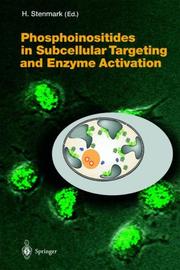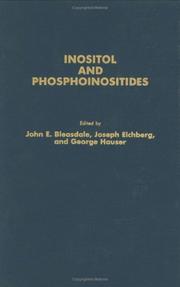| Listing 1 - 10 of 24 | << page >> |
Sort by
|
Book
ISBN: 0841217068 Year: 1999 Publisher: Washington, District of Columbia : American Chemical Society,
Abstract | Keywords | Export | Availability | Bookmark
 Loading...
Loading...Choose an application
- Reference Manager
- EndNote
- RefWorks (Direct export to RefWorks)

Abstract | Keywords | Export | Availability | Bookmark
 Loading...
Loading...Choose an application
- Reference Manager
- EndNote
- RefWorks (Direct export to RefWorks)
Book
Year: 1969 Publisher: New York (N.Y.) : New York academy of sciences,
Abstract | Keywords | Export | Availability | Bookmark
 Loading...
Loading...Choose an application
- Reference Manager
- EndNote
- RefWorks (Direct export to RefWorks)
Cyclitols --- Phosphoinositides --- Inositol --- Phosphatidylinositols --- Cyclitols. --- Phosphoinositides.

ISSN: 0070217X ISBN: 3540009507 Year: 2004 Publisher: Berlin Springer
Abstract | Keywords | Export | Availability | Bookmark
 Loading...
Loading...Choose an application
- Reference Manager
- EndNote
- RefWorks (Direct export to RefWorks)

ISBN: 0896030741 Year: 1985 Publisher: Humana press
Abstract | Keywords | Export | Availability | Bookmark
 Loading...
Loading...Choose an application
- Reference Manager
- EndNote
- RefWorks (Direct export to RefWorks)
Inositol --- Phosphoinositides --- Metabolism --- Congresses
Book
ISBN: 0879693045 Year: 1987 Publisher: Cold Spring Harbor (N.Y.) : Cold Spring Harbor laboratory,
Abstract | Keywords | Export | Availability | Bookmark
 Loading...
Loading...Choose an application
- Reference Manager
- EndNote
- RefWorks (Direct export to RefWorks)
Cellular control mechanisms --- Inositol --- Phosphoinositides --- Second messengers (Biochemistry) --- Metabolism
Book
Abstract | Keywords | Export | Availability | Bookmark
 Loading...
Loading...Choose an application
- Reference Manager
- EndNote
- RefWorks (Direct export to RefWorks)
In response to environmental stresses, or during development, plant cells will produce lipids that will act as intracellular or intercellular mediators. Glycerophospholipid and/or sphingolipid second messengers resulting from the action of lipid metabolizing enzymes (e.g. lipid-kinases or lipases) are commonly found within cells. The importance of such mediating lipids in plants has become increasingly apparent. Responses to biotic and abiotic stresses, and to plant hormones, all appear to involve and require lipid signals. Likewise, developmental processes, in particular polarized growth, seem also to involve signalling lipids. Amongst these lipids, phosphatidic acid (PA) has received the most attention. It can be produced by phospholipases D, but also by diacylglycerol kinases coupled to phospholipases C. Proteins that bind phosphatidic acid, and for which the activity is altered upon binding, have been identified. Furthermore, other lipids are also important in signalling processes. PA can be phosphorylated into diacylglycerol-pyrophosphate, and plants are one of the first biological models where the production of this lipid has been reported, and its implication in signal transduction have been demonstrated. PA can also be deacylated into lyso- phosphatidic acid. The phosphorylated phosphatidylinositols, i.e. the phosphoinositides, can act as substrate of phospholipases C, but are also mediating lipids per se, since proteins that bind them have been identified. Other important lipid mediators belong to the sphingolipid family such the phosphorylated phytosphingosine, or long-chain bases. Many questions remain unanswered concerning lipid signalling in plants. Understanding and discussing current knowledge on these mechanisms will provide insights into plant mechanisms in response to constraints, either developmental or environmental.
lipid-kinases --- Inositolphosphates --- diacylglycerolpyrophosphate --- Phospholipases --- phosphatidic acid --- lipid signaling --- phosphoinositides
Book
Abstract | Keywords | Export | Availability | Bookmark
 Loading...
Loading...Choose an application
- Reference Manager
- EndNote
- RefWorks (Direct export to RefWorks)
The phosphatidylinositol 3-kinase (PI3K)/mTOR pathway integrates signals from growth factors with nutrient signals and other conditions and controls multiple cell responses, including proliferation, survival and metabolism. Deregulation of the PI3K pathway has been extensively investigated in connection to cancer. Somatic or inherited mutations frequently occur in tumor suppressor genes (PTEN, TSC1/2, LKB1) and oncogenes (PIK3CA, PIK3R1, AKT) in the PI3K/mTOR pathway. The fact that the PI3K/mTOR pathway is deregulated in a large number of human malignancies, and its importance for different cellular responses, makes it an attractive drug target. Pharmacological PI3K inhibitors have played a very important role in studying cellular responses involving these enzymes. Currently, a wide range of selective PI3K inhibitors have been tested in preclinical studies and some have entered clinical trials in oncology. Rapamycin and its analogs targeting mTOR are effective in many preclinical cancer models. Although rapalogs are approved for the treatment of some cancers, their efficacy in clinical trials remains the subject of debate. Due to the complexity of the PI3K/mTOR signaling pathway, developing an effective anti-cancer therapy remains a challenge. The biggest challenge in curing cancer patients with various signaling pathway abnormalities is to target multiple components of different signal transduction pathways with mechanism-based combinatorial treatments.
Cancer. --- Phosphoinositides. --- Phosphoinositide 3-kinase --- mTOR --- clinical trials --- Akt --- Cancer
Book
Abstract | Keywords | Export | Availability | Bookmark
 Loading...
Loading...Choose an application
- Reference Manager
- EndNote
- RefWorks (Direct export to RefWorks)
The phosphatidylinositol 3-kinase (PI3K)/mTOR pathway integrates signals from growth factors with nutrient signals and other conditions and controls multiple cell responses, including proliferation, survival and metabolism. Deregulation of the PI3K pathway has been extensively investigated in connection to cancer. Somatic or inherited mutations frequently occur in tumor suppressor genes (PTEN, TSC1/2, LKB1) and oncogenes (PIK3CA, PIK3R1, AKT) in the PI3K/mTOR pathway. The fact that the PI3K/mTOR pathway is deregulated in a large number of human malignancies, and its importance for different cellular responses, makes it an attractive drug target. Pharmacological PI3K inhibitors have played a very important role in studying cellular responses involving these enzymes. Currently, a wide range of selective PI3K inhibitors have been tested in preclinical studies and some have entered clinical trials in oncology. Rapamycin and its analogs targeting mTOR are effective in many preclinical cancer models. Although rapalogs are approved for the treatment of some cancers, their efficacy in clinical trials remains the subject of debate. Due to the complexity of the PI3K/mTOR signaling pathway, developing an effective anti-cancer therapy remains a challenge. The biggest challenge in curing cancer patients with various signaling pathway abnormalities is to target multiple components of different signal transduction pathways with mechanism-based combinatorial treatments.
Cancer. --- Phosphoinositides. --- Phosphoinositide 3-kinase --- mTOR --- clinical trials --- Akt --- Cancer
Book
Abstract | Keywords | Export | Availability | Bookmark
 Loading...
Loading...Choose an application
- Reference Manager
- EndNote
- RefWorks (Direct export to RefWorks)
In response to environmental stresses, or during development, plant cells will produce lipids that will act as intracellular or intercellular mediators. Glycerophospholipid and/or sphingolipid second messengers resulting from the action of lipid metabolizing enzymes (e.g. lipid-kinases or lipases) are commonly found within cells. The importance of such mediating lipids in plants has become increasingly apparent. Responses to biotic and abiotic stresses, and to plant hormones, all appear to involve and require lipid signals. Likewise, developmental processes, in particular polarized growth, seem also to involve signalling lipids. Amongst these lipids, phosphatidic acid (PA) has received the most attention. It can be produced by phospholipases D, but also by diacylglycerol kinases coupled to phospholipases C. Proteins that bind phosphatidic acid, and for which the activity is altered upon binding, have been identified. Furthermore, other lipids are also important in signalling processes. PA can be phosphorylated into diacylglycerol-pyrophosphate, and plants are one of the first biological models where the production of this lipid has been reported, and its implication in signal transduction have been demonstrated. PA can also be deacylated into lyso- phosphatidic acid. The phosphorylated phosphatidylinositols, i.e. the phosphoinositides, can act as substrate of phospholipases C, but are also mediating lipids per se, since proteins that bind them have been identified. Other important lipid mediators belong to the sphingolipid family such the phosphorylated phytosphingosine, or long-chain bases. Many questions remain unanswered concerning lipid signalling in plants. Understanding and discussing current knowledge on these mechanisms will provide insights into plant mechanisms in response to constraints, either developmental or environmental.
lipid-kinases --- Inositolphosphates --- diacylglycerolpyrophosphate --- Phospholipases --- phosphatidic acid --- lipid signaling --- phosphoinositides
| Listing 1 - 10 of 24 | << page >> |
Sort by
|

 Search
Search Feedback
Feedback About UniCat
About UniCat  Help
Help News
News